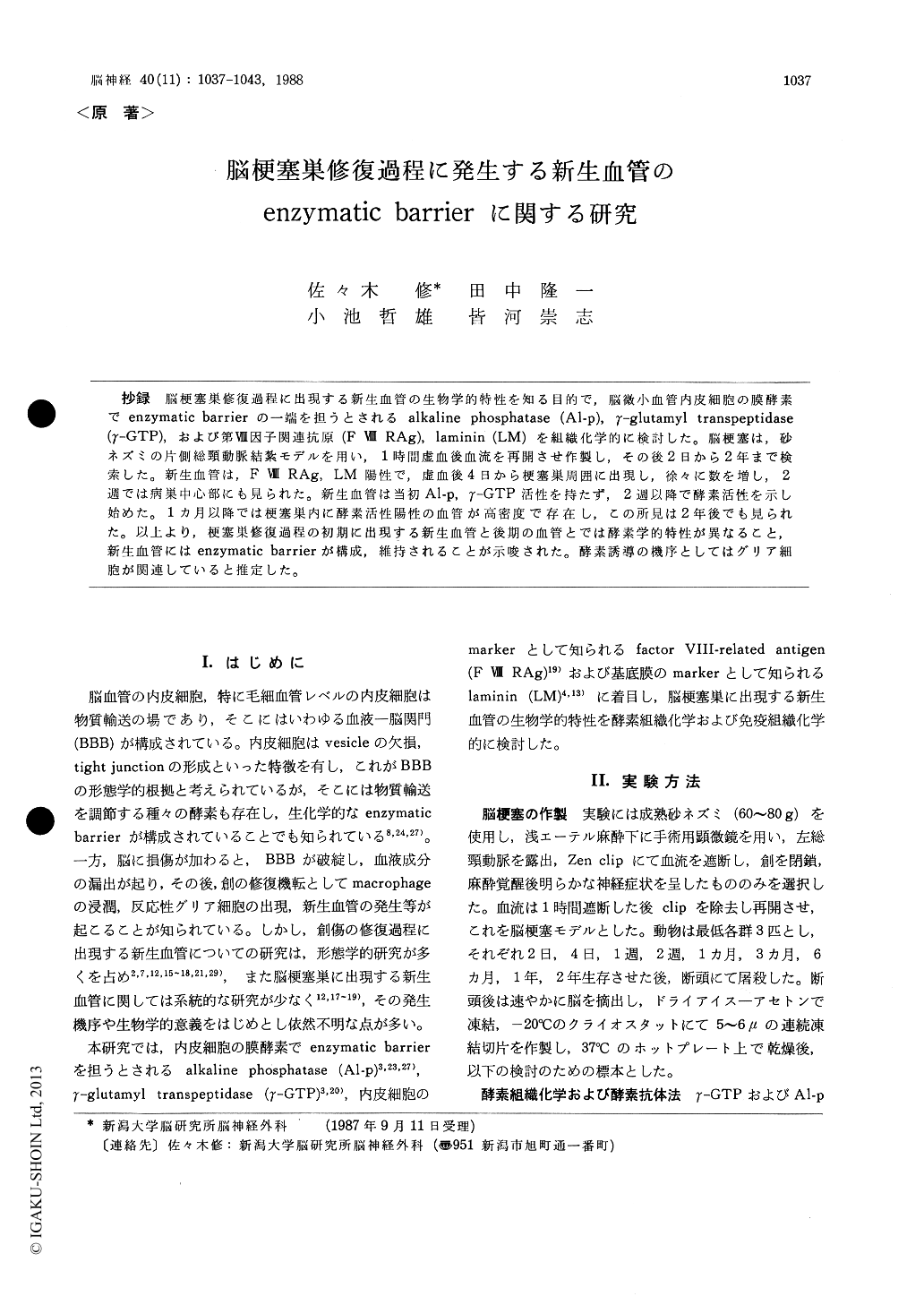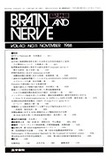Japanese
English
- 有料閲覧
- Abstract 文献概要
- 1ページ目 Look Inside
抄録 脳梗塞巣修復過程に出現する新生血管の生物学的特性を知る目的で,脳微小血管内皮細胞の膜酵素でenzymatic barrierの一端を担うとされるalkaline phosphatase (A1-P),γ-glutamyl transpeptidase(γ-GTP),および第VIII因子関連抗原(VIIIAg),laminin (LM)を組織化学的に検討した。脳梗塞は,砂ネズミの片側総頸動脈結紮モデルを用い,1時間虚血後血流を再開させ作製し,その後2日から2年まで検索した。新生血管は,FVIIIAg,LM陽性で,虚血後4日から梗塞巣周囲に出現し,徐々に数を増し,2週では病巣中心部にも見られた。新生血管は当初A1—p,γ—GTP活性を持たず,2週以降で酵素活性を示し始めた。1カ月以降では梗塞巣内に酵素活性陽性の血管が高密度で存在し,この所見は2年後でも見られた。以上より,梗塞巣修復過程の初期に出現する新生血管と後期の血管とでは酵素学的特性が異なること,新生血管にはenzymatic barrierが構成,維持されることが示唆された。酵素誘導の機序としてはグリア細胞が関連していると推定した。
To investigate the properties of the vessels newly formed in cerebral infarcts, we performed enzyme histochemical study for alkaline phospha-tase and γ-glutamyl transpeptidase that are mem-brane enzyme of capillary endothelial cells in the brain as well as immunohistochemical study for factor VIII related antigen and laminin.
Adult mongolian gerbils were used in the ex-periment to produce cerebral infarcts. The animals showing clear neurological signs of ischemia after occlusion of the left common carotid artery were selected. Following one hour ischemia blood flow was reperfused and the animals were allowed to grow and sacrificed at predetermined intervals ranging from two days to two years. The stain-ings for alkaline phosphatase and γ-glutamyl trans-peptidase were performed by Brustone method and Rutenburg method respectively, and those for factor VIII related antigen and laminin by PAP method, in frozen sections.
Four days after ischemia, vessels of a slightly large size that were running irregularly with reac-tivity of factor VIII related antigen and circum-scribed by laminin were observed in the marginal zone of the infarcts. These newly formed vessels increased in number during the second and the third week also in the center of the infarcts, and one month after ischemia began to decrease. However, a number of vessels were seen in the infarcts, whose features were comparatively simi-lar to those of normal vessels. These vessels remained as long as for two years. The number of the vessels with alkaline phosphatase and γ-glutamyl transpeptidase activity did not increase during the first week. They increased later dur-ing the second and third week. One month after ischemia, the majority of the vessels present in the infarcts showed alkaline phosphatase and γ-glutamyl transpeptidase activity. These vessels also continued to exist for two years.
The present study revealed that the properties of the vessels newly formed in an early stage of the repair of the infarcts and those seen in a late stage were enzymatically different. It is generally accepted that alkaline phosphatase and γ-glutamyl transpeptidase constitute the components of the enzymatic barrier mechanism in endothelil cells of cerebral capillaries. Therefore, the present dataseems to indicate the reconstitution of the enzy-matic barrier in endothelial cells of the newly formed vessels in the infarcts. The mechanism of the reconstitution is unclear, but we have specu-lated that an intimate interaction between glialcells and endothelial cells that are reestablished during the repair of the infarcts might be an inductive force for the enzymatic activities in the endothelial cells.

Copyright © 1988, Igaku-Shoin Ltd. All rights reserved.


